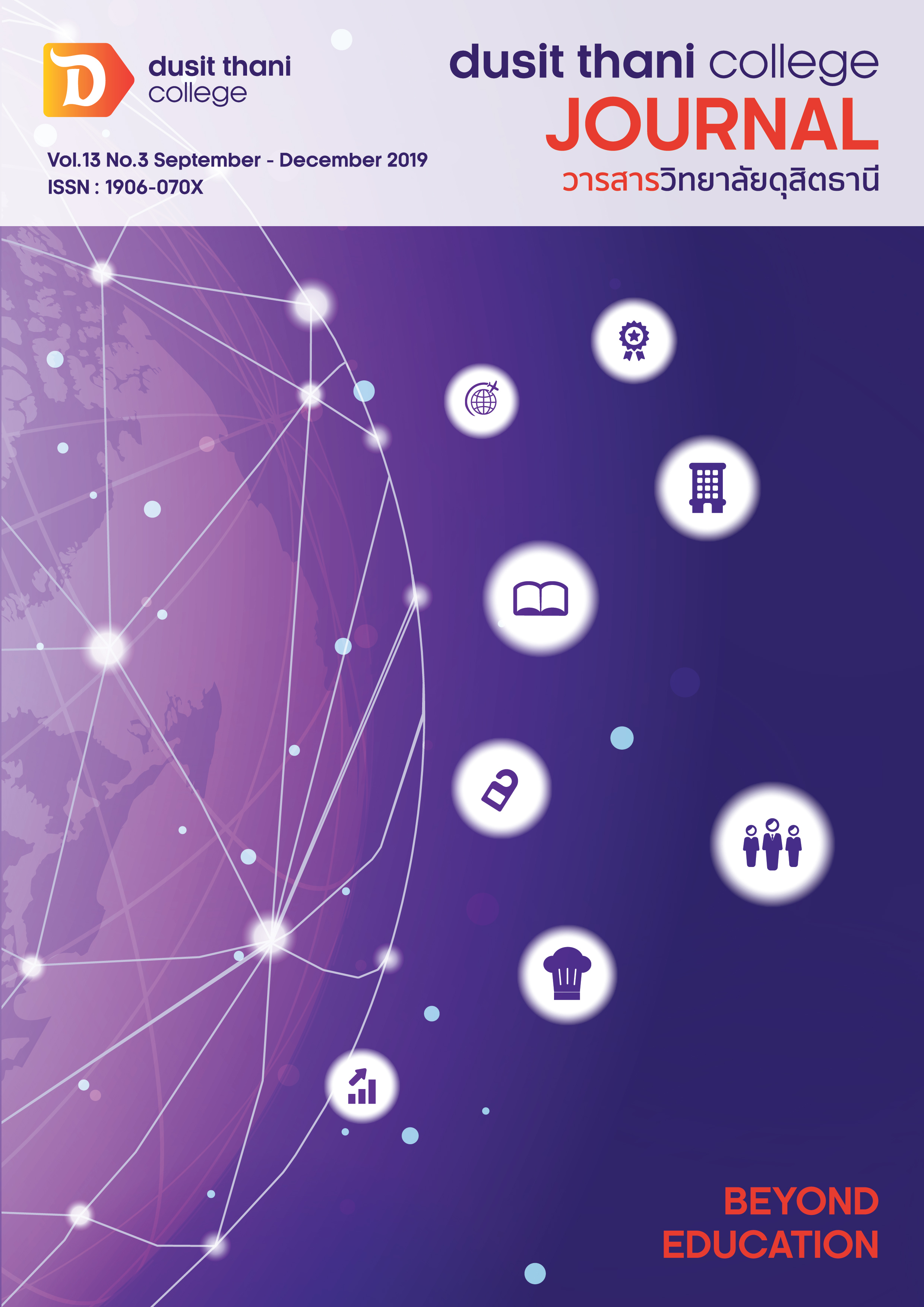แนวทางการพัฒนาธุรกิจบริการเพื่อส่งเสริมการเป็นผู้สูงอายุที่มีศักยภาพ (พฤฒพลัง) ในประเทศไทย
Main Article Content
บทคัดย่อ
การพัฒนาของเทคโนโลยีและการแพทย์สมัยใหม่ทำให้ประชากรโลกมีอายุยืนยาวขึ้นและแข็งแรงขึ้น จำนวนผู้สูงวัยได้เพิ่มขึ้นทั่วโลกรวมทั้งประเทศไทย หากแต่การเห็นคุณค่าของผู้สูงอายุในประเทศไทยกลับลดน้อยลงท่ามกลางการเปลี่ยนแปลงของเศรษฐกิจ สังคมและวัฒนธรรม คุณค่าของผู้สูงอายุในประเทศไทยลดน้อยถอยลง สอดคล้องกับผลจากการสำรวจทัศนคติของคนรุ่นใหม่ที่มีต่อผู้สูงอายุ ซึ่งรายงานผลว่าคนรุ่นใหม่มองผู้สูงอายุเชิงลบมากขึ้นจากในอดีต (Thai Gerontology Research and Development Institute, 2011) ความร่วงโรยของวัยและค่านิยมที่แปรเปลี่ยนได้มอบบทบาททางสังคมให้ผู้สูงอายุถูกมองเป็นเพียง “ผู้รับ” หรือ “ผู้พึ่งพิง” จากวัยแรงงานและสวัสดิการของรัฐเท่านั้น กลุ่มผู้สูงอายุไทยไม่ได้ยอมจำนนต่อภาพลักษณ์และทัศนคติด้านลบโดยได้สะท้อนอัตลักษณ์ผ่านคำว่า “พฤฒพลัง” หรือกลุ่มผู้สูงอายุที่มีศักยภาพ ซึ่งสามารถดูแลสุขภาพตนเอง มีความมั่นคง สามารถร่วมพัฒนาเศรษฐกิจ สังคมและวัฒนธรรมได้(World Health Organization, 2002) ถึงแม้ผู้สูงอายุไทยยังเผชิญกับข้อจำกัดต่าง ๆ อยู่มาก แต่ปัจจุบันก็มีองค์กรเอกชนที่ทำธุรกิจบริการสำหรับผู้สูงอายุมากขึ้น โดยธุรกิจบริการต่าง ๆ มีส่วนช่วยเสริมสร้างคุณภาพชีวิตของผู้สูงอายุที่มีจำนวนเพิ่มขึ้นอย่างต่อเนื่อง การศึกษาธุรกิจบริการสำหรับผู้สูงอายุนี้สามารถแนะแนวทางการให้บริการที่สอดคล้องต่อความต้องการของผู้สูงอายุได้อย่างแท้จริง บทความฉบับนี้มีวัตถุประสงค์ คือ 1) เพื่อศึกษาลักษณะการบริการสำหรับผู้สูงอายุไทยตามความต้องการพื้นฐานของผู้สูงอายุ 2) เพื่อนำเสนอแนวทางการพัฒนาธุรกิจบริการสำหรับผู้สูงอายุที่มีศักยภาพในประเทศไทย โดยบทความฉบับนี้ได้ถ่ายทอดองค์ความรู้จากการรวบรวมวรรณกรรมที่เกี่ยวข้อง จนได้ประเด็นสำคัญที่จะเป็นประโยชน์ เพื่อภาคส่วนที่เกี่ยวข้องกับผู้สูงอายุได้เห็นแนวทางการทำธุรกิจการให้บริการผู้สูงอายุด้วยความเข้าใจและตรงตามความต้องการ
Article Details
นโยบายการพิจารณากลั่นกรองบทความ
- บทความวิจัยและบทความวิชาการทุกเรื่องที่จะได้รับการตีพิมพ์ต้องผ่านการพิจารณากลั่นกรองโดยผู้ทรงคุณวุฒิ (Peer Review) ในสาขาที่เกี่ยวข้อง จำนวน 3 ท่าน/บทความ
- บทความ ข้อความ ภาพประกอบและตารางประกอบที่ลงตีพิมพ์ในวารสารเป็นความคิดเห็นส่วนตัวของผู้เขียน กองบรรณาธิการไม่จำเป็นต้องเห็นด้วยเสมอไป และไม่มีส่วนรับผิดชอบใด ๆ ถือเป็นความรับผิดชอบของผู้เขียนแต่เพียงผู้เดียว
- บทความที่จะได้รับการตีพิมพ์จะต้องไม่เคยตีพิมพ์ เผยแพร่ที่ใดมาก่อน และไม่อยู่ระหว่างการพิจารณาของวารสารฉบับอื่น หากตรวจสอบพบว่ามีการตีพิมพ์ซ้ำซ้อน ถือเป็นความรับผิดชอบของผู้เขียนแต่เพียงผู้เดียว
- บทความใดที่ผู้อ่านเห็นว่าได้มีการลอกเลียนหรือแอบอ้างโดยปราศจากการอ้างอิง หรือทำให้เข้าใจผิดว่าเป็นผลงานของผู้เขียน กรุณาแจ้งให้กองบรรณาธิการวารสารทราบจะเป็นพระคุณยิ่ง
เอกสารอ้างอิง
2. Brown Panitee. (2014). Active Aging: Roles of the Aged Groups and “Capitals”. Journal of Humanities and Social Science, Khon Kaen University. 31(3): 97-120.
3. Central Intelligence Agency (2017). The World Factbook. Retrieved on August 10, 2019 from https://www.cia.gov/library/publications/the-world-factbook/fields/214.html
4. Crabtree (1967), A. P. (1967). Education-The Key to Successful Aging. Adult Education, 17(3), 157-163.
5. Department of Business Development. (2017). Service Business. Retrieved on September 2, 2019 from https://www.dbd.go.th/download/article/article_20170519141052.pdf
6. Gronroos, C. (1990) Service Management and Marketing: Managing the Moments of Truth in Service Competition. Lexington Books, Lexington.
7. Hiransomboon, Katanyu. (2013). Service Management.
8. Kaewsuwanna, Khamphirat. Active Ageing Innovation for Self-Independence of Ageing People in Nakhon Ratchasima Province. Journal of Rangsit Graduate Studies in Business and Social Sciences. 2(2): 28-42.
9. Klilertphairoj, Weerarat. (2004). Service Marketing. Bangkok: SE-EDucation.
10. Lovelock C. H. (2002), Principles of Service Marketing and Management, Upper Saddle River, N.J.: Prentice Hall.
11. National Elderly Committee. (2010). The national elderly plan, vol.2 (2002-2021) (1st ed). Bangkok: Thepphannayayan Printing House.
12. Ross C.E., & Bird, C.E. (1994). Sex stratification and health lifestyle: consequences for men’s and women across 30 years: Three perspectives. Journal of Personality 70(1), 79-102.
13. Ross, C.E., & Mirowsky, J. (1995). Does employment affect health? Journal of Health and Social Behavior, 230-243.
14. Samorjai, Chatayaporn (2002), Service Marketing and Management. Bangkok: SE-Education.
15. Sukolpuk, Masarin and Boonchuaythanasit, Karuntharat. (2017). Health dimension of active ageing: A systematic review. Journal of Health Science Research. 11 (Supplement): 53-63. Retrieved on September 1, 2019 from https://www.tcithaijo.org/index.php/JHR/article/view/107913
16. Shounchupon, Amonlux. (2018). Service Business Management for Older Adults. Bangkok: SE-Education.
17. Supawan, Sarojbhan. (2016). The Practices of Everyday Life and Elderly People’s Negotiating Identities. Journal of Social Sciences and Humanities. 42(2): 34-58
18. Tangpattamachart, Sarawan and Sontirat, Supanee (2017 ) Cognitive Functioning,
Self-Reliance, Social Skills and Active Ageing of the Elderly at Tambon Bangsithong in Amphoe Bang Kruai, Nonthaburi Province. Journal of Behavioral Science for Development 9(1): 1-18.
19. Thai Gerontology Research and Development Institute. (2011). Situation of the Thai Elderly 2011. Retrieved on September 1, 2019 from http://thaitgri.org/?p=37046
20. The Technical Promotion and Support Offices 1-12 (2013), Directions of Elderly Services Consistent with Needs of the Pre Elderly.
21. The World Bank. (2019). Employment in Services (% of total employment) (modeled ILO estimate). Retrieved on September 1, 2019 from https://data.worldbank.org/indicator/sl.srv.empl.zs?end=2018&start=1991&view=chart
22. United Nations ESCAP. (2017a). World Population Ageing 2017 – Highlights. Retrieved on November 1, 2018 from https://www.un.org/en/development/desa/population/publications/pdf/ageing/WPA2017_Highlights.pdf
23. United Nations ESCAP. (2017b). Ageing in Asia and the Pacific Overview. Retrieved on November 1, 2018 from https://www.unescap.org/resources/ageing-asia-and-pacific- overview
24. Vannavanit, Yupawan (2005). Service Marketing Management. Bangkok:
Kasetsart University Press
25. World Health Organization. (2002). Active ageing: a policy framework.
(No. WHO/NMH/NPH/02.8). Geneva: World Health Organization.


